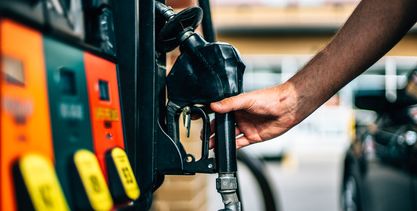U.S., Arkansas motorists to see pump price spike after Saudi drone attacks, analysts say
by September 17, 2019 2:08 pm 559 views

Last month’s forecast by the U.S. Department of Energy that Arkansans and other U.S. motorists would see lower pump prices for the remainder of 2019 may turn out to be premature.
According to the department’s Energy Information Administration (EIA) research group and other energy forecasters, motorists can expect some volatility at the pump in the coming days and weeks after Saudi Arabia experienced drone attacks at two major oil facilities – including the world’s largest crude process plant in the gated community of Abqaiq.
The attacks on Sept. 14 have taken 5.7 million (crude) barrels per day off the market, which represent about 6% of the global supply, EIA data shows. That led to the highest spike in international oil prices in a decade in Monday’s session on the New York Mercantile Exchange. On Monday, West Texas Intermediate (WTI) future, the premium U.S. light, sweet crude, closed up 14.7%, or $8.05, at $62.90 a barrel, the largest daily gain for the most-active contract since Sept. 22, 2008, according to Dow Jones Market Data.
In London, Brent crude spiked to $69.02 a barrel, its sharpest percentage gain on record and its biggest dollar rise since June 6, 2008.
“Americans can expect local pump prices to start to increase this week. The jump could end up being as much as a quarter per gallon throughout this month,” said Jeanette Casselano, AAA spokesperson. “Whether this is a short or long term trend will be determined by the price of crude oil prices and how quickly the facilities in Saudi Arabia can recover and get back online.”
PRODUCTION, IPO POSTPONED
Immediately after the attack, Saudi Arabia’s Ministry of Energy released a statement condemning the “unprecedented act of aggression and sabotage” that shut down nearly 50% of the kingdom’s production. Since the beginning of 2019, around 6.4 million barrels of Saudi Arabian crude oil has been imported around the world daily, according to data from HIS Markit.
“Initial investigations have indicated that the weapons used in the attack were Iranian weapons,” said the Royal Embassy of Saudi Arabia. “Investigations are still ongoing to determine the source of the attack.”
Just as concerning to financial markets is that the kingdom’s state-owned oil conglomerate, Saudi Aramco, postponed its upcoming fall initial public offering that will be handled by nearly a dozen Wall Street and international banks. That largest-ever IPO is expected to attract a valuation of nearly $2 trillion.
To ease market concerns, President Donald Trump said he has authorized the release of crude oil from the Strategic Petroleum Reserve. Other Saudi-oil-consuming countries also have emergency reserves to help back-fill the global loss, if needed.
EIA data shows that the U.S. now depends less on crude imports from Saudi Arabia than any other time over the last decade. For example, the U.S. only imported about 18,000 barrels per day in the first half of 2019, down 49.4% from 35,600 barrels per day in the first half of 2017.
In a report on Monday, IHS Markit’s Fotios Katsoulas noted that the majority of the Saudi Arabian oil has been absorbed by Asian importers, with China having imported marginally above 1.2 million barrels per day between January and August 2019. He said China is heavily relying on Saudi Arabia, which has supplied around 15% of the country’s seaborne imports. Japan and South Korea have also imported around 38% and 25% respectively, between January and August.
GAS STOCKPILES SHRINKING
Although the U.S. is now the world’s largest oil producer and no longer relies on foreign energy sources to power the nation, domestic gasoline stock levels have been decreasing the past few weeks and now sit at 228 million barrels. That level is still ahead of the five-year average for this time of year by several million barrels, said Casselano, but gaps in the market are likely to shrink as the market adjusts to Saudi production delays.
And Katsoulas warns that the drone attack against Abqaiq has been without doubt the largest disruption in history with a massive impact on oil prices. He said the balances between supply and demand may now turn fragile, which could lead to even higher crude oil prices.
“Even as clarity around the size of the damage remains sketchy, the market focus will be on how tight global supply could turn after this disruption, instead of panicking about world oil demand growth approaching its weakest levels since 2009,” he said. “There is simply no more spare capacity of global oil production left to secure energy security if geopolitical conflicts escalate.”
As of Tuesday, the national gas price average is creeping upward at $2.59 per gallon for regular unleaded, three cents higher than the previous day. That price, however, is three cents below a month ago and well below year ago levels at $2.84 per gallon.
Arkansas motorists are paying on average about $2.27 per gallon, also three cents higher than on Monday. Prices range from a low of $2.18 per gallon in the Hot Springs area to a high of $2.31 per gallon in the West Memphis/Memphis metropolitan area.
Based on its most recent short-term forecast, which is subject to change, EIA expects that the monthly average price of U.S. regular gasoline in 2019 peaked in May at $2.86 per gallon and anticipates that monthly average prices will range between $2.55 per gallon and $2.68 per gallon for the remainder of the year. EIA forecasts that annual U.S. regular gasoline prices will average $2.61 per gallon in 2019 and $2.70 per gallon in 2020.
